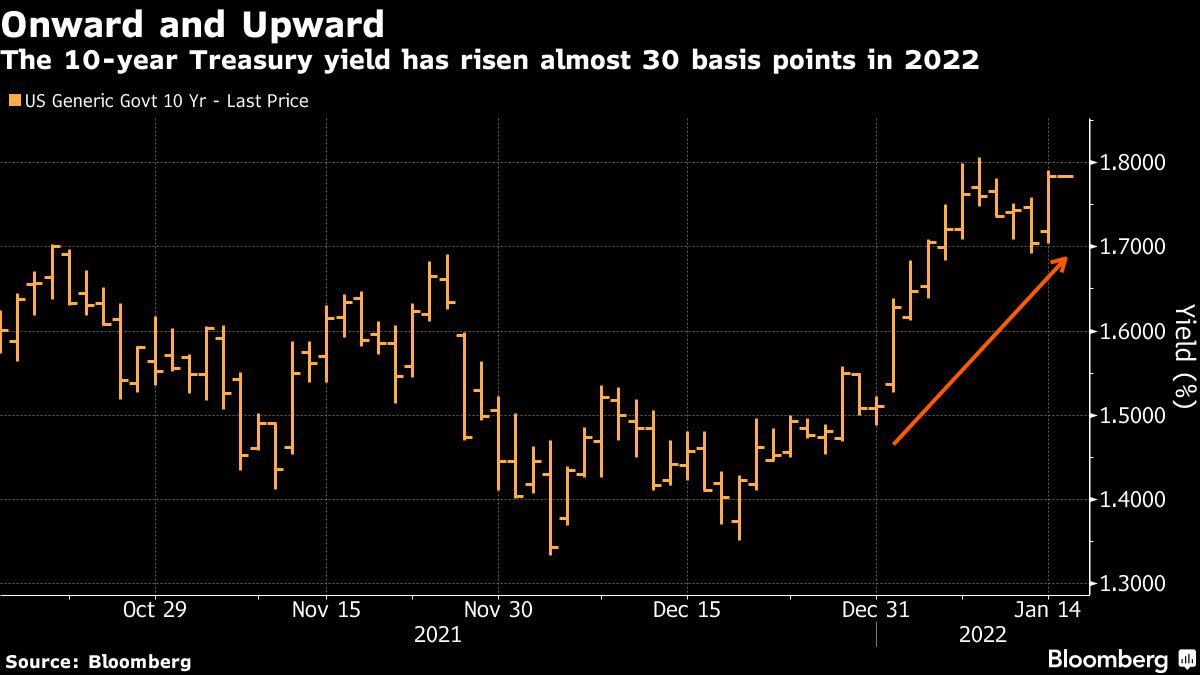What Strategists See for Markets as Treasury Yields Spike

(Bloomberg) — Treasury yields are quickly moving higher as investor expectations grow that the Federal Reserve will raise interest rates in March and follow up with further moves throughout the year.
Most Read from Bloomberg
The 10-year U.S. Treasury yield has risen almost 30 basis points since the end of 2021 as market participants begin to price rate hikes earlier and at a faster pace, with speculation about a 50 basis point move in March creeping into discussions.
Here are some views on how higher Treasury yields will play out across markets:
Dearth of Inflows
“The anticipation of higher yields is already impacting the broader market which has seen a weak start to the new year for equities,” said Adam Reynolds, chief executive officer for Asia-Pacific at Saxo Capital Markets Pte. via email Monday. “Typically we see inflows in January, which drive outperformance. This year that has not occurred. The more important consideration for me is the prospect of an early start to reducing the size of the Fed balance sheet. Any significant and early withdrawal of liquidity will have a negative impact on asset prices.”
“We are seeing a weak start for the week in both equities and fixed income,” Reynolds added. “My expectation is that this will continue throughout the week and even may start to accelerate.”
Downside for Gold
“Our overall view on asset allocation is built on the Federal Reserve starting its policy-rates hiking cycle in 2022 and subsequently the rise in UST yields,” said Tai Hui, chief Asia market strategist at J.P. Morgan Asset Management, in an email Monday. “We prefer equities over fixed income. Not only equities’ valuation is less demanding than fixed income, the duration risk relating to fixed income could be a challenge on generating positive return in 2022.”
He added that “rising yields, especially rising real yields, are going to be a downside risk for gold and other assets that do not generate income.”
Growth Versus Value
“The outlooks for the Fed, interest rates, and economic growth suggest equity investors should balance their exposures to growth and value,” said Goldman Sachs Group Inc. strategists led by David Kostin, in a note Friday. “Our rates strategists expect yields will continue to rise, a dynamic that should support value over growth.”
The firm’s economists are calling for U.S. growth to rise to 3% in the second quarter from 2% in the first, supporting value stocks. But by the fourth quarter, growth will ease again, boosting growth stocks instead, according to their forecasts.
Dollar Bear Bets
“The dissonance associated with the juxtaposition of higher Treasury yields and a softer U.S. dollar stemming from the underlying hawkish Fed divergence (vis-a-vis the European Central Bank and Bank of Japan) reveals the many tensions that dwell beneath,” said Vishnu Varathan, head of economics and strategy at Mizuho Bank Ltd., in a note Monday.
“Insofar that a hawkish Fed is augmenting inflation expectations lower, real UST yields have been climbing; catching up with, and potentially overtaking the rise in nominal yields,” he continued. “And if sustained, this lift in real rates should inspire USD traction, if not rebound. If indeed the real (rates) U.S. dollar stands up, one-way bearish bets on the dollar will fumble.”
Big Tech
“A weak tech season coupled with the higher rate environment we think augers in more selling in the Nasdaq 100,” said Michael Purves, chief executive officer of Tallbacken Capital Advisers LLC, in a note Sunday. “And it is hard to think that won’t spill over to broader index pressure. Yes, value should see rotational dynamics, but that the big tech weight in the SPX is a hefty boat anchor to carry around if it needs to get sold.
“With that said, it is interesting to see that while the SPX options market is somewhat middling, the VXN (a VIX for the NDX) has been steadily climbing,” he said. “Since early December, the VXN – VIX spread has been climbing in higher than the VIX in tandem with the NDX’s underperformance relative to the SPX. And both of these metrics have concurred with the rise in the 10-year Treasury yield and hawkish pivot.”
Real Reservations
“Broadly speaking, rising real yields are negative for risk assets,” said Sue Trinh, head of global macro strategy Asia at Manulife Investment Management HK Ltd., in comments Monday. “We find that higher real rates are likely more painful for risk assets than higher nominal rates.”
She added, “crucially, the correlation between real yields and risk assets has become stronger and more negative in the past five years.”
Crypto Divergence
There’s been a big divergence in performance recently between the largest cryptocurrencies and some of those that are emerging, notes Jonathan Cheesman, head of over-the-counter and institutional sales at crypto-derivatives exchange FTX, who pointed to weak returns from the likes of Bitcoin and Ether in the past month, while tokens like NEAR and Fantom have surged.
“This decorrelation could relate back to the macro environment (i.e. Fed tightening) in two ways,” Cheesman said. “1) Traditional investors have been focusing on the large caps and as a large part of their thesis was monetary inflation, they are presumably exiting. 2) While tightening is coming, it’s not here yet. There is still a huge amount of liquidity in the system, so we are seeing large gyration under the surface without as much volatility on the index or aggregate level.”
Reversal
“If the Fed intends to raise interest rates and potentially sell off the assets they have accumulated over the past 12 years, this could result in a reversal of the bond/equity bull markets, which we have been accustomed to for so long,” said Takatoshi Shibayama, head of sales for APAC at Copper.co.
(Adds JPM AM and Copper.co comments.)
Most Read from Bloomberg Businessweek
©2022 Bloomberg L.P.




